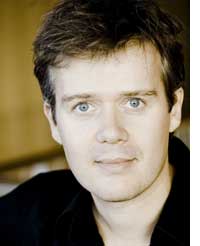Michel van der Aa: interview about The Book of Disquiet

Michel van der Aa’s new music theatre work, The Book of Disquiet, is premiered in Linz in January, starring Klaus Maria Brandauer
The Book of Disquiet is based on texts by the Portuguese poet Fernando Pessoa (1888-1935). How did you discover his writings?
I’d read a few of his poems but it was Airan Berg, one of the artistic directors of Linz09, who suggested basing a theatre piece on Pessoa and I was excited to learn that the actor Klaus Maria Brandauer would be interested in such a project. Then I started reading more of Pessoa’s writings and homed in on what I think is his masterpiece, The Book of Disquiet, a collection of fragmentary texts, diary entries and autobiographical anecdotes only published 50 years after the poet’s death.
Were you attracted to Pessoa’s technique of writing through a series of alter-egos? This has links with your interests in masks and the multiple representation of characters.
Yes, Pessoa often casts himself in a series of distinct characters, ‘heteronyms’ as he calls them, both male and female. I was intrigued by the idea that the sum of these doubles could provide a total representation of the poet. This gave me the scope for the video element of the piece: the actor on stage represents the central character of The Book of Disquiet, the Lisbon bookkeeper Bernardo Soares, but he is also seen on the video as himself and as a series of alter-egos acted by three men and one woman. The drama is his coming to terms with his identity.
How did you transform Pessoa’s fragments into a theatrical shape?
The Book of Disquiet was assembled from loose sheets of paper, found in a box trunk on Pessoa’s death. I had to narrow the texts down through a process of selection in order to create a piece that could exist in ‘real’ time in the theatre. The task wasn’t as hard as I feared because a series of recurring themes emerged, allowing me to group the fragments by subject matter, for instance isolation, love or dreams.
George Steiner has described The Book of Disquiet as a “haunting mosaic of dreams”. How have you created this dreamworld in visual terms?
There are realistic scenes with the alter-egos of Bernardo Soares but also scenes that are much more abstract, drawing upon entries found in the book to create a more dreamlike mise-en-scène. So the video switches between imagery that literally extends the physical events on stage, and more surreal scenes that make us delve deeper into the mind of the protagonist.
The fracturing of time and personality can give Pessoa’s works a dark colour. How did you vary this in the theatre?
I also found texts with a distinctive, ironic brand of humour, for instance when he talks about unhappily married women including “all who are married and some who are single”. He is also very playful with language, having worked as a translator, so I’ve used these elements to lighten the philosophical tone. To break up the spoken text I’ve set some poems by Pessoa for the vocalist Ana Moura, who sings them on the video where she appears as the female double of the bookkeeper, the enigmatic herdswoman with the ox.
What form did your collaboration with Klaus Maria Brandauer take?
We met a number of times in the early days to discuss the project and Klaus watched the films of One and After Life to get a feel for my work. Collaborating with musicians holds no fears for him, having performed A Survivor from Warsaw and Egmont with conductors like Karajan and Bernstein. Once he’d seen how I incorporate film elements into my music theatre pieces he became excited about working with video projections. The next stage was to make a recording of him reading the text, so that I could model the music and rhythmic structures to match his inflections. During the composition phase he kept his distance and gave me the space to go my own way. It was totally inspiring working with Klaus on the video, watching his sheer professionalism in the face of what I demanded of him.
How do speech and music interact in the work?
In many sections the spoken text is rhythmically notated so that synchronisation can be achieved, while in others Klaus is paired with instrumental soloists whose playing interacts with his free speech. The ensemble consists of 15 players - wind, strings and percussion – and there is an electronic element with pre-recorded samples, processed sounds of the ensemble, plus the songs and speech.
What other projects do you have in the coming months?
There are a number of performances of Mask: in London by members of the Philharmonia Orchestra on 9 October and in Vilnius by the Ensemble Modern on 26 October. I’ve also completed a new song cycle, Spaces of Blank, written for the wonderful mezzo-soprano Christianne Stotijn and the Royal Concertgebouw Orchestra to premiere next March, with further performances planned by Radio France and the NDR Orchestra. I looked for texts that would suit Christianne’s dark brown voice and theatrical presence, and selected poems by Emily Dickinson, Anne Carson and Rozalie Hirs. They all describe anxiety by making an analogy with a space or building, and during the piece we follow the mezzo as she moves through these virtual spaces. There are dark sections with very edgy orchestral outbursts, but also some engaging moments of real intimacy.
Interview by David Allenby
> Further information on Performance: The Book of Disquiet
> Further information on Work: The Book of Disquiet
Photo: Marco Borggreve
